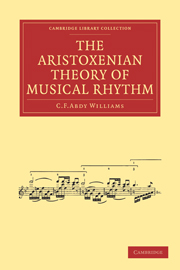Book contents
- Frontmatter
- PREFACE
- Contents
- MUSICAL ILLUSTRATIONS
- INTRODUCTION
- CHAPTER I
- CHAPTER II
- CHAPTER III
- CHAPTER IV
- CHAPTER V
- CHAPTER VI
- CHAPTER VII
- CHAPTER VIII
- CHAPTER IX
- CHAPTER X
- APPENDIX A Quotations, from original sources, of passages referred to in the text
- APPENDIX B Glossary of Technical Terms
- APPENDIX C Dactylo-epitritic, Logaœdic, and Dochmiac rhythms, and rhythmical modulation. M. Laloy's views
- INDEX
- Frontmatter
- PREFACE
- Contents
- MUSICAL ILLUSTRATIONS
- INTRODUCTION
- CHAPTER I
- CHAPTER II
- CHAPTER III
- CHAPTER IV
- CHAPTER V
- CHAPTER VI
- CHAPTER VII
- CHAPTER VIII
- CHAPTER IX
- CHAPTER X
- APPENDIX A Quotations, from original sources, of passages referred to in the text
- APPENDIX B Glossary of Technical Terms
- APPENDIX C Dactylo-epitritic, Logaœdic, and Dochmiac rhythms, and rhythmical modulation. M. Laloy's views
- INDEX
Summary
The Aristoxenian theory of magnitudes with their limitations may appear somewhat laboured; yet music, as we have seen, can only be made comprehensible by some kind of limitation of its rhythmopceia.
But, the reader may say, what about Wagner's music? If we look through the score of “Tristan und Isolde,” for example, we find not a single harmonic close, not a musical punctuation, or “resting place for the mind,” until the middle of the second scene of the first Act.
It will be remembered that Aristoxenus says of the greater feet that “having a magnitude difficult to be grasped by the sense, they need many notes, so that the magnitude of the whole foot, being divided into many parts, becomes more easily understood.”
Wagner's method of making his music understood without the regular recurrence of periodic closes is the same in principle as that of Aristoxenus: there runs throughout it a constant recurrence of short striking rhythmical figures, which take the place of the “many notes” of Aristoxenus. By their means the composer is able to follow every phase of the dramatic feeling without hindrance, and at the same time to make his music acceptable to the “aisthēsis.” Wagner, therefore, unconsciously applied the Aristoxenian principle on a large scale.
- Type
- Chapter
- Information
- The Aristoxenian Theory of Musical Rhythm , pp. 70 - 88Publisher: Cambridge University PressPrint publication year: 2009First published in: 1911



